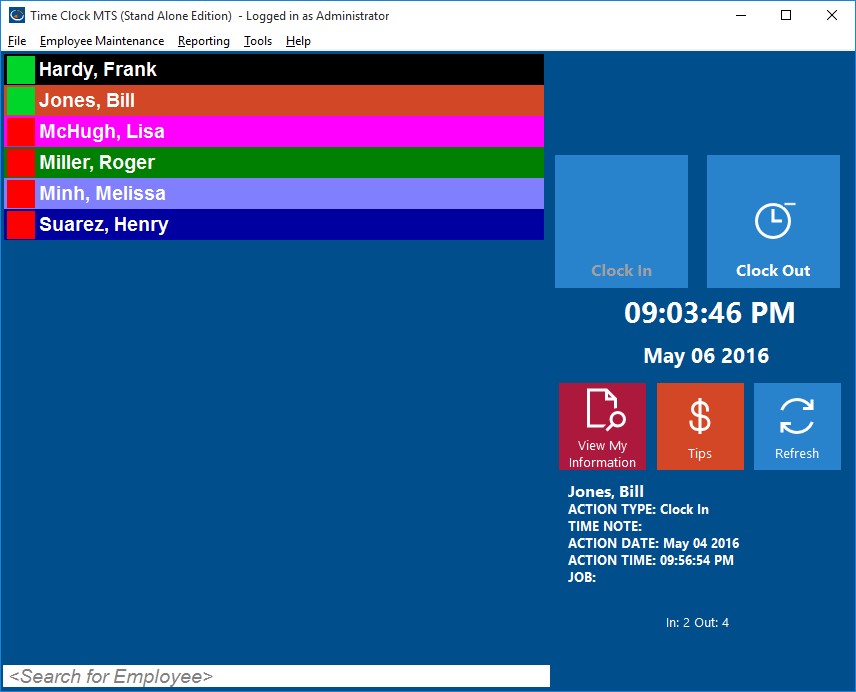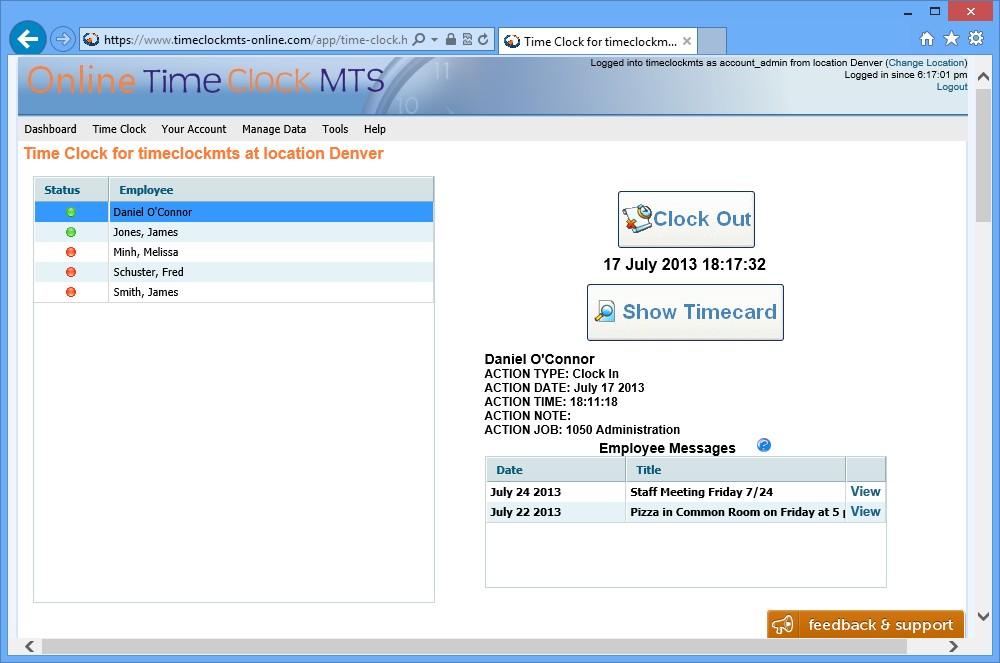Just recently I was interviewed for an upcoming article on a fairly popular small business news website. The article addresses the question “What is Timecard Software?”. As part of this interview I answered some questions the journalist sent me via email about time card software. I thought it would be useful to reproduce those answers in a blog article.
1. What is timecard software and how does it work?
Time card software is used to collect information about when employees arrive at work, when they take breaks, and when they leave for the day. It is designed to replace paper timesheets, punch clock machines, and time card machines. The software will store this time card information and make it available to payroll staff and managers so they can run reports to work out employee payroll, what employees are spending their time on, and who is (or isn’t) at work. Typically timecard software takes one of two forms. The first is installable software that shares data across your network and allows your employees to clock in and out on one or more computers. The second, is a web based time card system that allows employees to clock in and out via a web-enabled device. These days a third type of system is becoming more popular, namely time card apps on mobile devices. However, these are typically linked to some sort of web based timecard system anyway.
2. What are the benefits of using such software?
There are three main benefits to using time card software. The first, is that it will save a company money. Cost savings come through reducing the time taken for manual payroll calculations, a big reduction in payroll errors, reducing employee time theft, and reducing consumable costs from manual timesheet systems. The second area of improvement will be freeing up of time of both payroll staff and employees. A good time card system should make processing payroll much faster and should allow employees to clock in and out very quickly and easily. This time saved can be spent improving other areas of the business. The final benefit is one of increased employee satisfaction. Obviously payroll staff will be happier because their jobs are easier. But less obviously, normal employees should be happier with a good time card system. Payroll errors should be reduced, they should be able to see quickly and easily what vacation / sick time they have owing, and if the time card system allows it, they should be able to request time off and communicate easily with payroll staff using the time card software.
3. What are the drawbacks?
Clearly any system is going to require up-front costs and on-going training for new and existing employees. Also, there’s almost always going to be a need for an internal “product champion” that people can fall back on if there are questions or issues with the time card system. Other problems can be more technical especially if the time card software is installable rather than web-based. Computers can fail and the time card software can be incompatible with new operating systems. This can lead to an on-going cost of ownership that web-based time card systems do not have. The final drawback is usually one of employee resistance. Some employees will hate the idea of a system that can track their times accurately and cannot be manipulated. This problem is more of a cultural one rather than a drawback of the software itself. It is, however, an important problem that must be addressed.
4. Can employers use timecard software to help manage remote or offsite employees?
Off-site employees and remote employees are easily dealt with by web based time card systems. Such a system should allow employees to clock in or out with any web-enabled device or perhaps via an app on a smart phone. The data will be recorded back to a central server where it can be easily reported on by payroll staff. Installable desktop time card software can be a little more problematic, but the problems are not insurmountable. Remote login tools like Windows Terminal Services or even free tools like Log Me In make it fairly simple for a remote employee to clock in or out via a remote desktop connection.
5. What are things small business owners should look for in timecard software?
There’s probably 5 key things I’d recommend anyone look at before purchasing a timecard software system. The first is to ensure that the system is compatible with your computer system. The second is to evaluate both upfront and on-going costs. It’s simple to get fooled by a low cost system that has high on-going maintenance costs just to keep the software running.
The third area is one of technical support. Ensure your chosen vendor has excellent online support resources. My experience is that most people like to work out problems with their time clock software before picking up the telephone so make sure the online support resources are there. The fourth thing to consider is to ensure that the chosen system has the features you require. Look beyond the simple need to clock employees in and out and hourly rates. Look for the ability to deal with the sorts of overtime you need, look for vacation and sick time accruals and look for the ability to track time spent on jobs. The best way to work out if a timecard system has the features you want is to try it before you buy it. For at least one full payroll cycle.
The final thing to consider is ease of use and quality of reports. There’s no point having a system that is laborious to run and takes a lot of time to maintain and equally there’s no point having a time clock system that just doesn’t give you reports on the time clock data you need.
6. Do you see time timecard software becoming more of the norm moving forward?
Absolutely. There’s low cost time clock systems out there (such as “Time Clock MTS) that can be had for well under $100. Even if you’ve got just a few employees you’re likely to recoup that cost in time savings in just a month or two if you’re currently using a paper based time card system. We have users of Time Clock MTS who have 5 employees and users who have 1000 employees. They are all finding it worthwhile. We’ve also got a free version of Time Clock MTS available for companies who have less than 4 employees so there’s really no reason for even the smallest business not to be using time card software.
7. What do you think is holding back some businesses from adopting timecard software?
Three main areas. The first is a perception that there will be some sort of need for an internal IT whiz to keep your time card software running. A good time card system should be easy to install, simple for employees to use to clock in and out, and produce reports quickly and easily. The second area of concern most people have is one of security. They believe any time card system will be easy for employees to manipulate. A system like Time Clock MTS includes a raft of features to stop this. Including integration with fingerprint scanners, using internet time servers to set the internal software time, taking pictures of employees when the clock in or out, and a strong password system. The final reason is one of perceived cost. Sure, some systems are very expensive but there’s some really affordable installable and web-based time card systems out there these days that really do pay for themselves very quickly.



